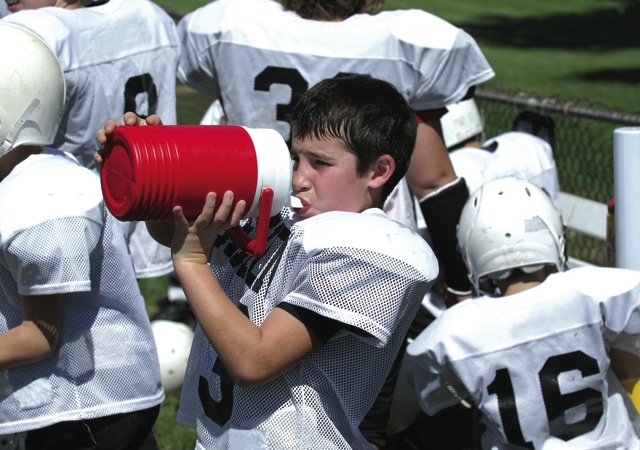High schools beginning to use devices prominent at college levels
Everything is bigger in Texas, and while that’s considered an advantage to coaching in the Lonestar State, it occasionally has its drawbacks.
Kent Scott learned that first hand. Nearly five years ago, the head football coach at Prosper High School discovered that playing in Texas’ imposing high school stadiums pushed his communication equipment to its limits. He needed to make a change.
 “We were starting to play in these bigger stadiums, and something they were using inside the glass at those stadiums started to mess with the transmission,” Scott said. “We bought a new system that was designed for larger stadiums, and we’re in a growing district so we felt like it was something we could add to as needed.”
“We were starting to play in these bigger stadiums, and something they were using inside the glass at those stadiums started to mess with the transmission,” Scott said. “We bought a new system that was designed for larger stadiums, and we’re in a growing district so we felt like it was something we could add to as needed.”
Prosper High School isn’t alone. Prep football has evolved into a different kind of game over the years, taking place in bigger venues with innovative equipment and devices designed to make the game safer and more manageable. In some ways, it’s mimicking what’s done at the college level, and high school teams are trying to adapt.
Scott’s team plays in a stadium that seats around 3,500. His old equipment worked just fine at home, but he needed it to operate seamlessly on the road.
Scott turned to CoachComm, where he purchased its Tempest FX wireless communication sets. Nine of his coaches use the system, and none of them have experienced problems managing games. Tempest FX uses the same technology as Division I college programs, eliminating interference and maximizing sound quality.
Scott said high-end communication devices are becoming more common in Dallas and other metropolitan schools, where football is king and athletic facilities are built like cathedrals. The cost can be difficult to endure for underfunded programs, but Scott said Prosper has an active booster club that made the purchase possible, and it’s been well worth it.
Glen West, football coach at Brenham High School in Texas, has been using wireless headsets for as long as he car remember, back when the technology was first making its way into prep sports.
At first, he hated it. His headsets would pick up interference from radio stations, telephone calls and truck driver conversations. He switched back to wired equipment before attending a convention, where CoachComm convinced him to give its wireless sets a try.
After that, the problems went away.
“There was a time you got anxious every time you turned on a headset, hoping that it would work,” West said. “Now there’s clarity and peace of mind. There was a period of time before we moved into a new system that if both (teams) had the same system, if you weren’t the first one to turn yours on, you were going to have problems.”
Playing like the college teams means preparing like them too, and Prosper is adjusting by making its practices as efficient as possible.
In addition to the Tempest FX, Kent’s program uses Tempo, CoachComm’s practice management system that helps coaches control the pace and energy of his practices. Tempo includes segment clocks, music and speakers that assists coaches and players no matter where they are on the field.
Texas is no stranger to boisterous crowds that can make on-the-field communication nearly impossible, so Tempo helps Kent simulate crowd noise during his practices. That helps players settle into a comfort zone and develop alternative means for communication in key moments when they aren’t able to call out audibles or hear snap counts.
Kent said the segment timers and music help move his practices along at a steady pace, which is a huge benefit to programs that’s are dealing with condensed time frames and little room for error in preparation.
“We’ve had segmented clocks ever since I’ve been coaching, but we used to put someone up in the bleachers with an air horn,” Kent said. “This has a segment timer and a big LED display so you know how much time you have left in the segment. I can’t tell you all the different ways you can tailor it to fit your practices.”
Kent acknowledges headsets and practice management systems are not something every school can afford, but high-tech gadgets and communication devices are becoming more prominent on high school fields. If teams plan to keep up with the competition, they should find a way to work with their administrators or fundraisers to upgrade their equipment.
In the long run, that’s only going to benefit the program and help players and coaches be more prepared when they step onto the field.
West said he plans to purchase Tempo when the latest version becomes available. When his school hosts events like the Fun Run, where more than 5,000 runners participate, it’s a system that’s going to help him communicate with everyone taking part.
“We’re always looking for the cutting edge,” he said. “And this seems to be able to provide that.”





